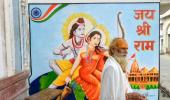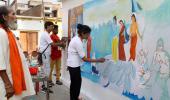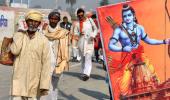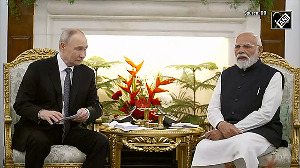'It is best that an amicable solution to the dispute is found outside the precincts of the courts of law,' says former Union home secretary Dr Madhav Godbole.
An exclusive excerpt from his new book, The Babri Masjid Ram Mandir Dilemma.

There is no getting away from the fact that, shorn of everything else, and in spite of the pleadings of the Hindu community, what is before the apex court is a land title dispute.
And as far as I can see, based on evidence, decision in the suit would have inevitably gone in favour of the Muslims, except for the outer courtyard around the mosque in which the Ram Chabootra and Sita-ki-Rasoi were located.
But, clearly, such a verdict would not have been acceptable to a section of the majority community.
We have seen the storm which erupted over the Supreme Court decision in the Shah Bano case in the mid-1980s and the Sabrimala case in 2018.
In the first case, a conservative section of the Muslim community was involved while in the second, a section of Hindus felt aggrieved.
Thus, there are limits even to the writ of the highest court in the land, where religious issues are involved. Therefore, it is best that an amicable solution to the Babri dispute is found outside the precincts of the courts of law.
Looking to the failure of repeated efforts of holding a dialogue between the contending parties so far, it is unlikely that the outcome will be any different this time except for the fact that the apex court has taken this initiative.
Any solution to this problem must come as a decision of the apex court so that it will not be challenged in yet another court case.
Right or wrong, acceptable or unacceptable, it must come as a decision of the court.
I am of the view that a number of issues, which were raised by both sides in earlier discussions, largely to strengthen their respective positions in public discourse, should no longer be considered relevant.

These included, for example, questions raised by the Muslim side, namely, whether Ram was a historical or mythological figure; proof of Ram's exact birthplace; historical proof of Ayodhya during the Ramayana period; exact location of the Saryu river; whether the Babri Masjid was constructed after the demolition of a temple; and whether there was an authentic evidence of a temple underneath the mosque; and from the Hindu side -- who constructed the Babri Masjid; it was never really a mosque; Muslims never prayed there; that the structure was constructed after demolition of a Ram temple; Hindus had fought for the liberation of Ram's birthplace right through history; and so on.
But the baggage of past positions is not easy to jettison. Deliberate efforts will have to be made by both sides to look to the future, rather than the past, in the search for an amicable solution.
The final solution must provide a healing touch. In devising it, recent history, cannot be forgotten or overlooked. The solution must also not be ad-hoc or temporary which would give rise to new questions in the future.
Resolving the dispute is far too important for the nation's integrity, safety and social cohesion.
Efforts are being made by the GoI, openly when the NDA is in power, and clandestinely when the Congress was in power (as in P V Narasimha Rao's term), to extend support for the construction of the Ram temple.
This is evident from the application made by the NDA government to the Supreme Court in January 2019 to allow it to return the 'excess/superfluous land' from the 67.703 acres it acquired in Ayodhya in 1993 to the original owners, namely, the Ram Janmabhoomi Nyas (42 acres) and others.
In doing so, the Centre is effectively asking the Supreme Court to do what it has objected to at least three times in the last 16 years on the ground that this would disturb 'peace and tranquillity'. This government move was ascribed to the delays in the hearing of the case by the Supreme Court.
The Indian Express has rightly commented editorially that, 'the Centre must await closure in the case in the Supreme Court and refrain from making any moves that could be construed as short-circuiting due process'.

The main question of openly debating the location of the Ram temple has been skirted all along. No one has asked the most pertinent question as to whether any part of the proposed temple would be over the land in dispute on which the Babri Masjid was located. Even during the days preceding the demolition of Babri Masjid same was the position. I had dealt with this at some length in my memoirs:

Even to this day, the temple plan has not formally come on government record, though during the discussion of the director of Intelligence Bureau, V G Vaidya, with Moropant Pingle of the Shiv Sena and Rajju Bhaiyya (Professor Rajender Singh) of the RSS in November 1992, three alternative plans were handed over by them to Vaidya.
In one of them, the sanctum sanctorum (garbha gruha) of the new temple was under the central dome of the Babri Masjid.
In another, the central dome of the Masjid was subsumed under the garbha gruha of the temple, and in the third alternative plan, the temple had been shown in front of the central dome of the Masjid.
I do not know which of these alternatives was their real choice and which were mere bargaining counters.
It must be noted that even after the demolition of the mosque and the gross injustice done to Muslims, the Narasimha Rao government did not have the courage to tell the court that the mosque would be rebuilt on the same site.
I am, however, of the firm view that the Muslims' intense feeling of hurt and injustice, due to the destruction of the place of their worship in secular India, can only be alleviated by giving them a portion of the land on which the Babri Masjid stood.
I am sure a large number of Hindus, a silent majority, have been shocked and distressed by the demolition of a place of worship and would like to make amends for it.
The basic principle of secularism is equal respect for all religions. Looking also to the experience of destruction and damage to some churches in the country, a law must be enacted to repair, reconstruct and rebuild, at government expense, any places of worship destroyed in communal violence.

Keeping in view the equally strong feelings of the Hindus about the site being Ram Janmabhoomi, I would suggest that the Ram Chabutra, on which puja was being carried out by Hindus since a long time, Sita-ki-Rasoi and the adjacent land be given for construction of a Ram temple.
The specious surrounding land should be used for landscaping and gardening, with a portion of it reserved for a children's playground.
A wall was constructed in 1855 between the Ram Chabutra and the Babri Masjid to avoid communal tensions. The idea of the wall may be revived, not as a wall, but as a vertical garden, a symbol of growth and rejuvenation, which conveys a message of unity rather than division.
Both places of worship should be open to all communities and should be declared as places of silent worship and communion with God. No loudspeakers or any other sound-enhancing equipment should be allowed in the precincts of either places of worship.
I hope my solution will be accepted not only by the two communities but by all sections of the society to bring a closure to this vexed conundrum. India must move on. India has many more peaks to climb.
This solution, if accepted by all parties, should be sanctified by the Supreme Court. This will put an end to the question of who represents Hindus and Muslims in this matter and will make it binding on all. All pending court cases should automatically abate thereafter.
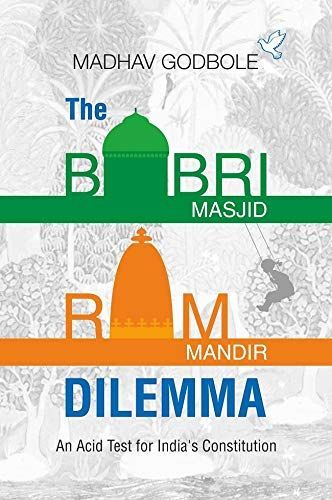
Finding an amicable solution to the dispute is important since it matters to the nation's conscience.
In the Mood of the Nation Survey carried out by India Today in 2019, one question asked was, 'Should the NDA government construct a Ram Temple on the disputed site in Ayodhya?', Sixty-nine per cent of the voters were in favour of construction of the temple, 22 per cent were opposed to it and 9 per cent did not have any opinion.
Among the Hindus who participated in the survey, 74 per cent were in favour.
Interestingly, among the Muslims surveyed, 28 per cent were in favour, presumably hoping that this will usher communal harmony in the country.
Another question asked was, 'Should the government build the Ram temple via an ordinance?' Sixty-seven per cent replied in the affirmative. The results show, in broad magnitudes, how important the dispute is nationally, and how equally important it is to find a lasting solution to it.
The minority judgment of the Supreme Court delivered by Justice A M Ahmadi and Justice S P Bharucha in the Ayodhya Reference dated October 24, 1994 had rightly underlined:
The amicable solution I have suggested is based on the fervent belief in the acceptance of all faiths. Inter-mixing of religion and politics in India is an explosive and high-voltage hazard.
As the Liberhan Commission has observed [The RSS and its affiliate organisations] 'practised intermingling of religion with politics as a well thought out act to subvert democracy'. To avoid the recurrence of more 'Ayodhyas', by whatever name, in the future, the agreement among interested parties should include a plea to Parliament and all political parties to take concerted, expeditious action on the amendment of the Constitution to separate religion from politics, shift the entries 'public order' and 'police' from the State List to the Concurrent List, and set up a constitutional commission on secularism, to deal with the emerging issues transparently, effectively and expeditiously.
I trust the readers will agree that this is not too much to ask for.
Excerpted from The Babri Masjid Ram Mandir Dilemma by Madhav Godbole, with the kind permission of the publishers, Konark Publishers Pvt Ltd.
Dr Madhav Godbole was India's home secretary when the Babri Masjid was demolished in December 1992. He resigned from the Indian Administrative Service soon after.
